SKODA OCTAVIA 2011 2.G / (1Z) Service Manual
Manufacturer: SKODA, Model Year: 2011, Model line: OCTAVIA, Model: SKODA OCTAVIA 2011 2.G / (1Z)Pages: 248, PDF Size: 3.79 MB
Page 41 of 248
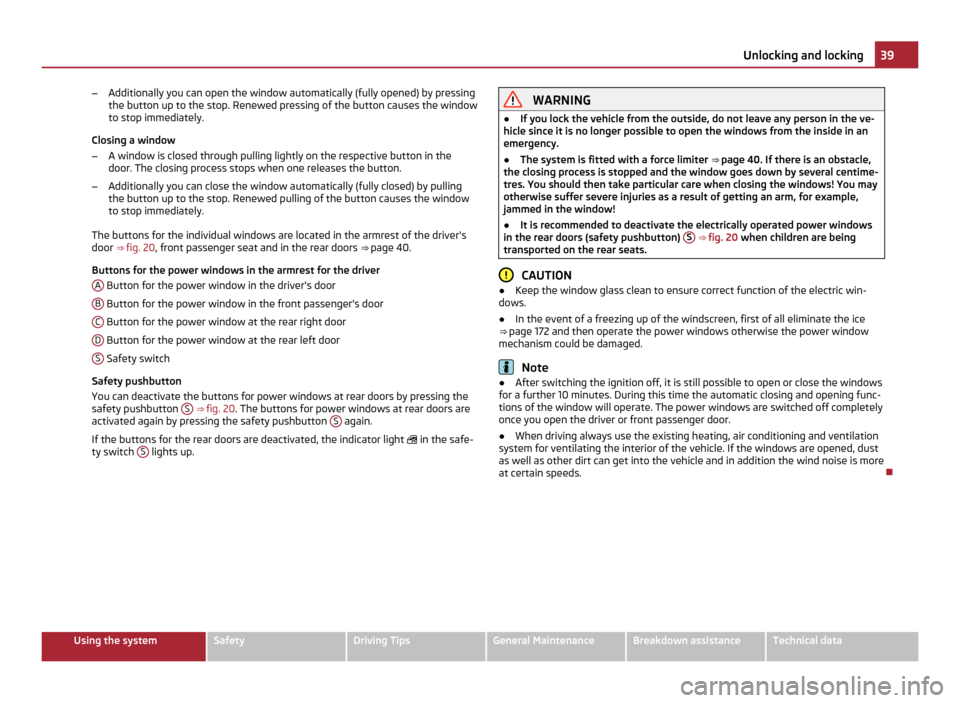
–
Additionally you can open the window automatically (fully opened) by pressing
the button up to the stop. Renewed pressing of the button causes the window
to stop immediately.
Closing a window
– A window is closed through pulling lightly on the respective button in the
door. The closing process stops when one releases the button.
– Additionally you can close the window automatically (fully closed) by pulling
the button up to the stop. Renewed pulling of the button causes the window
to stop immediately.
The buttons for the individual windows are located in the armrest of the driver's
door ⇒
fig. 20, front passenger seat and in the rear doors ⇒ page 40.
Buttons for the power windows in the armrest for the driver A Button for the power window in the driver's door
B Button for the power window in the front passenger's door
C Button for the power window at the rear right door
D Button for the power window at the rear left door
S Safety switch
Safety pushbutton
You can deactivate the buttons for power windows at rear doors by pressing the
safety pushbutton S
⇒ fig. 20 . The buttons for power windows at rear doors are
activated again by pressing the safety pushbutton S again.
If the buttons for the rear doors are deactivated, the indicator light in the safe-
ty switch S lights up. WARNING
● If you lock the vehicle from the outside, do not leave any person in the ve-
hicle since it is no longer possible to open the windows from the inside in an
emergency.
● The system is fitted with a force limiter ⇒ page 40
. If there is an obstacle,
the closing process is stopped and the window goes down by several centime-
tres. You should then take particular care when closing the windows! You may
otherwise suffer severe injuries as a result of getting an arm, for example,
jammed in the window!
● It is recommended to deactivate the electrically operated power windows
in the rear doors (safety pushbutton) S ⇒
fig. 20 when children are being
transported on the rear seats. CAUTION
● Keep the window glass clean to ensure correct function of the electric win-
dows.
● In the event of a freezing up of the windscreen, first of all eliminate the ice
⇒
page 172 and then operate the power windows otherwise the power window
mechanism could be damaged. Note
● After switching the ignition off, it is still possible to open or close the windows
for a further 10 minutes. During this time the automatic closing and opening func-
tions of the window will operate. The power windows are switched off completely
once you open the driver or front passenger door.
● When driving always use the existing heating, air conditioning and ventilation
system for ventilating the interior of the vehicle. If the windows are opened, dust
as well as other dirt can get into the vehicle and in addition the wind noise is more
at certain speeds. 39
Unlocking and locking Using the system Safety Driving Tips General Maintenance Breakdown assistance Technical data
Page 42 of 248

Button in the front passenger door and in the rear doors
Fig. 21 Position of button in front pas-
senger door
A button for the relevant window is provided in these doors.
Opening a window
– Lightly press the appropriate button down and hold it until the window has
moved into the desired position.
– Additionally you can open the window automatically (fully opened) by pressing
the button down up to the stop. Renewed pressing of the button causes the
window to stop immediately.
Closing a window
– Lightly press the appropriate button up and hold it until the window has
moved into the desired position.
– Additionally you can close the window automatically (fully closed) by pressing
the button up up to the stop. Renewed pressing of the button causes the win-
dow to stop immediately. WARNING
The system is fitted with a force limiter ⇒ page 40 . If there is an obstacle,
the closing process is stopped and the window goes down by several centime-
tres. You should then take particular care when closing the windows! You may
otherwise suffer severe injuries as a result of getting an arm, for example,
jammed in the window! Note
● After switching the ignition off, it is still possible to open or close the windows
for a further 10 minutes. During this time the automatic closing and opening func-
tions of the window will operate. The power windows are switched off completely
once you open the driver or front passenger door.
● If the child safety lock is switched on, the lighting of the switch for the win-
dow lifter in the rear doors is not activated.
Force limiter of the power windows The electrically operated power windows are fitted with a force limiter. It reduces
the risk of bruises or injuries when closing the windows.
If there is an obstacle, the closing process is stopped and the window goes down
by several centimetres.
If the obstacle prevents the window from being closed during the next 10 sec-
onds, the closing process is interrupted once again and the window goes down by
several centimetres.
You must try to close the window once again within 10 seconds after the window
has gone down twice, even if the obstacle was not yet removed, the closing proc-
ess is stopped. During this time it is not possible to automatically close the win-
dow. The force limiter is still switched on.
The force limiter is only switched off, if you attempt to close the window within
the next 10
seconds – the window closes now with full strength!
If you wait longer than 10 seconds, the force limiter is switched on again. WARNING
You should take particular care when closing the windows! You may otherwise
suffer severe injuries as a result of getting an arm, for example, jammed in the
window!
Window convenience operation You can open and close the electrically powered windows as follows when un-
locking and locking the vehicle (only close the sliding/tilting roof):
£40
Unlocking and locking
Page 43 of 248
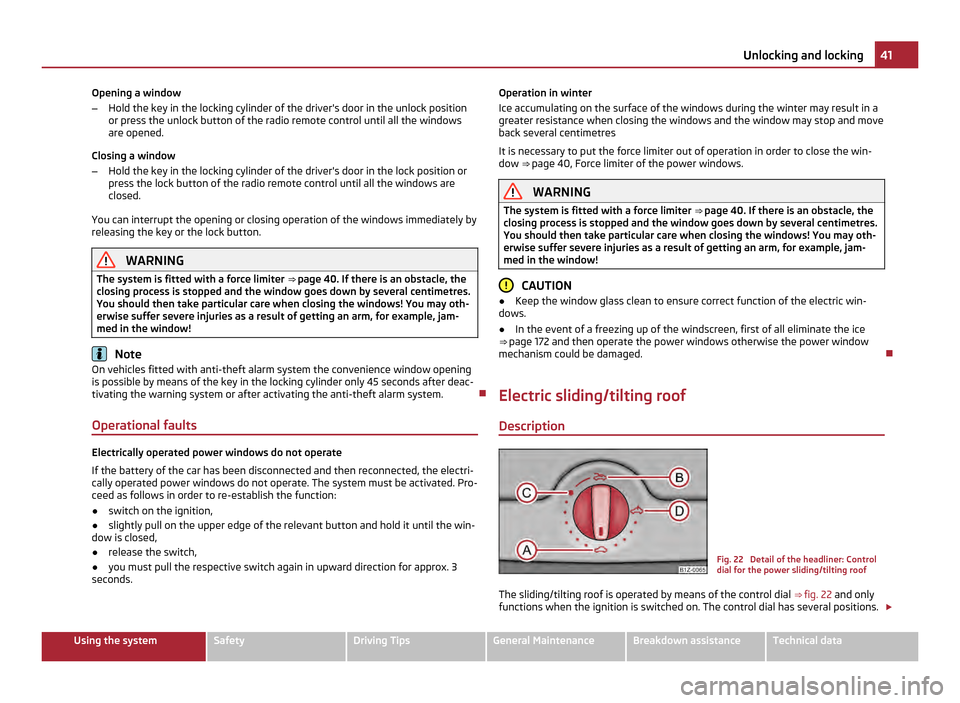
Opening a window
–
Hold the key in the locking cylinder of the driver's door in the unlock position
or press the unlock button of the radio remote control until all the windows
are opened.
Closing a window
– Hold the key in the locking cylinder of the driver's door in the lock position or
press the lock button of the radio remote control until all the windows are
closed.
You can interrupt the opening or closing operation of the windows immediately by
releasing the key or the lock button. WARNING
The system is fitted with a force limiter ⇒ page 40 . If there is an obstacle, the
closing process is stopped and the window goes down by several centimetres.
You should then take particular care when closing the windows! You may oth-
erwise suffer severe injuries as a result of getting an arm, for example, jam-
med in the window! Note
On vehicles fitted with anti-theft alarm system the convenience window opening
is possible by means of the key in the locking cylinder only 45 seconds after deac-
tivating the warning system or after activating the anti-theft alarm system.
Operational faults Electrically operated power windows do not operate
If the battery of the car has been disconnected and then reconnected, the electri-
cally operated power windows do not operate. The system must be activated. Pro-
ceed as follows in order to re-establish the function:
● switch on the ignition,
● slightly pull on the upper edge of the relevant button and hold it until the win-
dow is closed,
● release the switch,
● you must pull the respective switch again in upward direction for approx. 3
seconds. Operation in winter
Ice accumulating on the surface of the windows during the winter may result in a
greater resistance when closing the windows and the window may stop and move
back several centimetres
It is necessary to put the force limiter out of operation in order to close the win-
dow ⇒ page 40, Force limiter of the power windows
. WARNING
The system is fitted with a force limiter ⇒ page 40
. If there is an obstacle, the
closing process is stopped and the window goes down by several centimetres.
You should then take particular care when closing the windows! You may oth-
erwise suffer severe injuries as a result of getting an arm, for example, jam-
med in the window! CAUTION
● Keep the window glass clean to ensure correct function of the electric win-
dows.
● In the event of a freezing up of the windscreen, first of all eliminate the ice
⇒
page 172 and then operate the power windows otherwise the power window
mechanism could be damaged.
Electric sliding/tilting roof Description Fig. 22 Detail of the headliner: Control
dial for the power sliding/tilting roof
The sliding/tilting roof is operated by means of the control dial ⇒ fig. 22 and only
functions when the ignition is switched on. The control dial has several positions. £ 41
Unlocking and locking Using the system Safety Driving Tips General Maintenance Breakdown assistance Technical data
Page 44 of 248
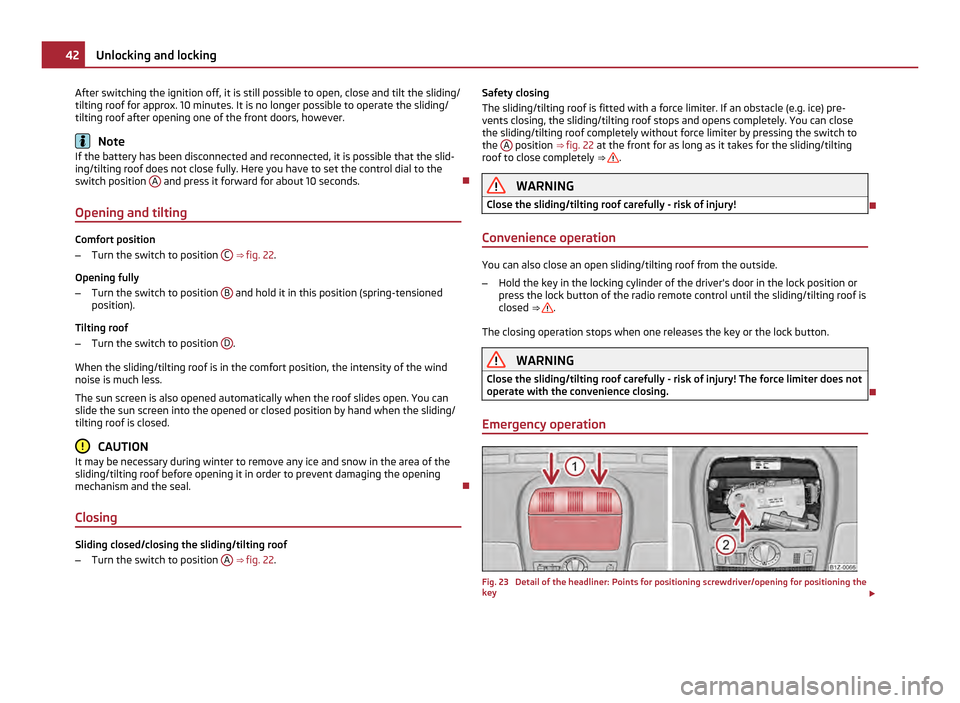
After switching the ignition off, it is still possible to open, close and tilt the sliding/
tilting roof for approx. 10 minutes. It is no longer possible to operate the sliding/
tilting roof after opening one of the front doors, however. Note
If the battery has been disconnected and reconnected, it is possible that the slid-
ing/tilting roof does not close fully. Here you have to set the control dial to the
switch position A and press it forward for about 10 seconds.
Opening and tilting Comfort position
–
Turn the switch to position C
⇒ fig. 22 .
Opening fully
– Turn the switch to position B and hold it in this position (spring-tensioned
position).
Tilting roof
– Turn the switch to position D .
When the sliding/tilting roof is in the comfort position, the intensity of the wind
noise is much less.
The sun screen is also opened automatically when the roof slides open. You can
slide the sun screen into the opened or closed position by hand when the sliding/
tilting roof is closed. CAUTION
It may be necessary during winter to remove any ice and snow in the area of the
sliding/tilting roof before opening it in order to prevent damaging the opening
mechanism and the seal.
Closing Sliding closed/closing the sliding/tilting roof
–
Turn the switch to position A
⇒ fig. 22 . Safety closing
The sliding/tilting roof is fitted with a force limiter. If an obstacle (e.g. ice) pre-
vents closing, the sliding/tilting roof stops and opens completely. You can close
the sliding/tilting roof completely without force limiter by pressing the switch to
the A position
⇒ fig. 22 at the front for as long as it takes for the sliding/tilting
roof to close completely ⇒ .
WARNING
Close the sliding/tilting roof carefully - risk of injury!
Convenience operation You can also close an open sliding/tilting roof from the outside.
–
Hold the key in the locking cylinder of the driver's door in the lock position or
press the lock button of the radio remote control until the sliding/tilting roof is
closed ⇒ .
The closing operation stops when one releases the key or the lock button. WARNING
Close the sliding/tilting roof carefully - risk of injury! The force limiter does not
operate with the convenience closing.
Emergency operation Fig. 23 Detail of the headliner: Points for positioning screwdriver/opening for positioning the
key £42
Unlocking and locking
Page 45 of 248

You can close and/or open the sliding/tilting roof by hand if the system is defect.
–
Position the flat blade of a screwdriver carefully against the rear edge of the
cover for the electrical drive at the points of the arrows 1 ⇒ fig. 23 on the left.
– Pull the cover down.
– Insert an Allen key, Group 4, up to the stop into the opening at the point of the
arrow 2 and close and/or open the sliding/tilting roof
⇒ fig. 23 on the right.
– Press on the cover again by first of all inserting the plastic lugs and then push-
ing the cover up.
– Have the fault rectified by a specialist workshop. Note
It is necessary after each emergency operation (using Allen key) to move the slid-
ing/tilting roof into the basic position. Here you have to turn the control dial for-
ward to the switch position A ⇒
fig. 22 and press for about 10 seconds. 43
Unlocking and locking Using the system Safety Driving Tips General Maintenance Breakdown assistance Technical data
Page 46 of 248

Lights and Visibility
Lights
Switching lights on and off Fig. 24 Dash panel: Light switch
Switching on side lights
– Turn the light switch ⇒ fig. 24 into position .
Switching on the low beam and main beam
– Turn the light switch into position .
– Push the main beam lever slightly forward in the spring-tensioned position in
order to switch on the main beam ⇒ fig. 30 .
Switching off lights (except daylight driving lights)
– Turn the light switch into position.
The dipped beam continues to shine while the ignition is switched on and the
light switch is in the position or . After switching off the ignition, the low
beam is switched off automatically and only the side lights come on. The parking
light also goes out after the ignition key is removed.
On vehicles with separate lights for daylight driving lights in the fog lights or in
the front bumper, the low beam does not light up when the light switch is in posi-
tion 0 even if the ignition is switched on.
On models fitted with right-hand steering the position of certain switches differs
from that shown in ⇒
fig. 24. The symbols which mark the switch positions are
identical, however. WARNING
Never drive with only the side lights on - risk of accident! The side lights are
not bright enough to light up the road sufficiently in front of you or to be seen
by other oncoming traffic. In this case, always switch on the low beam when it
is dark or if visibility is poor. Note
● If the light switch is in the position , the ignition key is removed and the
driver's door is open, an acoustic warning signal will sound. The acoustic warning
signal is switched off over the door contact when the driver's door is closed (igni-
tion off). The vehicle can be parked with the side lights on.
● If the light switch is in the position and the ignition key is removed, the
lights will go out.
● If the car is parked for a lengthy period, we recommend switching off all lights,
or leaving only the parking lights switched on.
● The switching on of the described lights should only be undertaken in accord-
ance with the legal requirements.
● If a fault occurs in the light switch, the low beam comes on automatically
● In the event of cool or humid weather conditions, the headlights can be misted
up from inside.
–The temperature difference between interior and external area of the head-
light lenses is decisive.
– When the driving lights are switched on, the light outlet surfaces are free
from mist after a short period. The headlight lenses can possibly mist up at the
border areas.
– It also concerns reverse light and turn signal lights.
– This mist has no influence on the life of the lighting system.
“DAY LIGHT” Switching on daylight driving lights
–
Switch on the ignition without turning the light switch out of the position 0 or
. £44
Lights and Visibility
Page 47 of 248
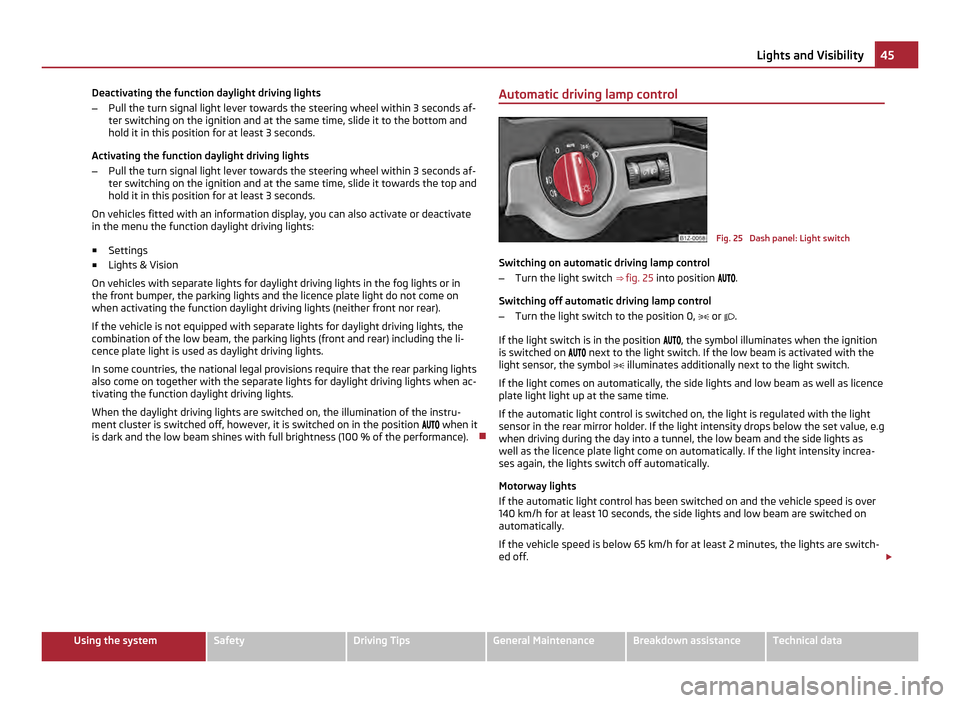
Deactivating the function daylight driving lights
–
Pull the turn signal light lever towards the steering wheel within 3 seconds af-
ter switching on the ignition and at the same time, slide it to the bottom and
hold it in this position for at least 3 seconds.
Activating the function daylight driving lights
– Pull the turn signal light lever towards the steering wheel within 3 seconds af-
ter switching on the ignition and at the same time, slide it towards the top and
hold it in this position for at least 3
seconds.
On vehicles fitted with an information display, you can also activate or deactivate
in the menu the function daylight driving lights:
■ Settings
■ Lights & Vision
On vehicles with separate lights for daylight driving lights in the fog lights or in
the front bumper, the parking lights and the licence plate light do not come on
when activating the function daylight driving lights (neither front nor rear).
If the vehicle is not equipped with separate lights for daylight driving lights, the
combination of the low beam, the parking lights (front and rear) including the li-
cence plate light is used as daylight driving lights.
In some countries, the national legal provisions require that the rear parking lights
also come on together with the separate lights for daylight driving lights when ac-
tivating the function daylight driving lights.
When the daylight driving lights are switched on, the illumination of the instru-
ment cluster is switched off, however, it is switched on in the position when it
is dark and the low beam shines with full brightness (100 % of the performance). Automatic driving lamp control Fig. 25 Dash panel: Light switch
Switching on automatic driving lamp control
– Turn the light switch ⇒ fig. 25 into position .
Switching off automatic driving lamp control
– Turn the light switch to the position 0, or .
If the light switch is in the position , the symbol illuminates when the ignition
is switched on next to the light switch. If the low beam is activated with the
light sensor, the symbol illuminates additionally next to the light switch.
If the light comes on automatically, the side lights and low beam as well as licence
plate light light up at the same time.
If the automatic light control is switched on, the light is regulated with the light
sensor in the rear mirror holder. If the light intensity drops below the set value, e.g
when driving during the day into a tunnel, the low beam and the side lights as
well as the licence plate light come on automatically. If the light intensity increa-
ses again, the lights switch off automatically.
Motorway lights
If the automatic light control has been switched on and the vehicle speed is over
140 km/h for at least 10 seconds, the side lights and low beam are switched on
automatically.
If the vehicle speed is below 65
km/h for at least 2 minutes, the lights are switch-
ed off. £ 45
Lights and Visibility Using the system Safety Driving Tips General Maintenance Breakdown assistance Technical data
Page 48 of 248
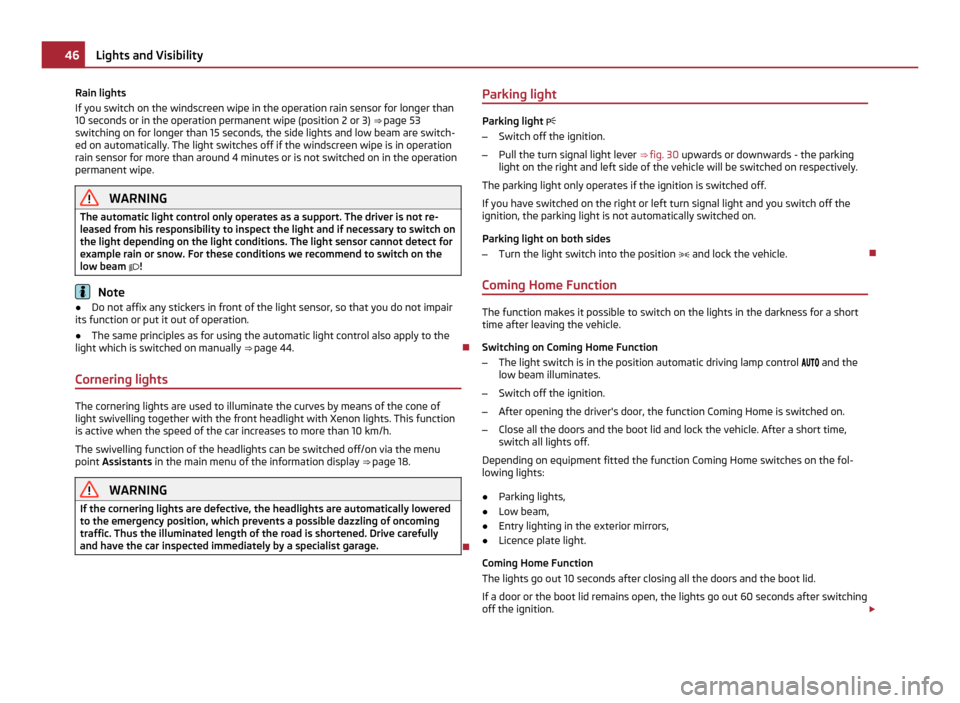
Rain lights
If you switch on the windscreen wipe in the operation rain sensor for longer than
10 seconds or in the operation permanent wipe (position
2 or 3) ⇒ page 53
switching on for longer than 15 seconds, the side lights and low beam are switch-
ed on automatically. The light switches off if the windscreen wipe is in operation
rain sensor for more than around 4 minutes or is not switched on in the operation
permanent wipe. WARNING
The automatic light control only operates as a support. The driver is not re-
leased from his responsibility to inspect the light and if necessary to switch on
the light depending on the light conditions. The light sensor cannot detect for
example rain or snow. For these conditions we recommend to switch on the
low beam ! Note
● Do not affix any stickers in front of the light sensor, so that you do not impair
its function or put it out of operation.
● The same principles as for using the automatic light control also apply to the
light which is switched on manually ⇒
page 44.
Cornering lights The cornering lights are used to illuminate the curves by means of the cone of
light swivelling together with the front headlight with Xenon lights. This function
is active when the speed of the car increases to more than 10
km/h.
The swivelling function of the headlights can be switched off/on via the menu
point Assistants in the main menu of the information display ⇒ page 18.WARNING
If the cornering lights are defective, the headlights are automatically lowered
to the emergency position, which prevents a possible dazzling of oncoming
traffic. Thus the illuminated length of the road is shortened. Drive carefully
and have the car inspected immediately by a specialist garage. Parking light Parking light
– Switch off the ignition.
– Pull the turn signal light lever ⇒
fig. 30 upwards or downwards - the parking
light on the right and left side of the vehicle will be switched on respectively.
The parking light only operates if the ignition is switched off.
If you have switched on the right or left turn signal light and you switch off the
ignition, the parking light is not automatically switched on.
Parking light on both sides
– Turn the light switch into the position and lock the vehicle.
Coming Home Function The function makes it possible to switch on the lights in the darkness for a short
time after leaving the vehicle.
Switching on Coming Home Function
– The light switch is in the position automatic driving lamp control and the
low beam illuminates.
– Switch off the ignition.
– After opening the driver's door, the function Coming Home is switched on.
– Close all the doors and the boot lid and lock the vehicle. After a short time,
switch all lights off.
Depending on equipment fitted the function Coming Home switches on the fol-
lowing lights:
● Parking lights,
● Low beam,
● Entry lighting in the exterior mirrors,
● Licence plate light.
Coming Home Function
The lights go out 10 seconds after closing all the doors and the boot lid.
If a door or the boot lid remains open, the lights go out 60 seconds after switching
off the ignition. £46
Lights and Visibility
Page 49 of 248

The function Coming Home is controlled with the light sensor in the mount of the
interior rear mirror. If the light intensity is higher than the set value of the light
sensor, the Coming Home Function is not switched on after switching off the igni-
tion. Note
● If the Coming Home Function is switched on constantly, the battery will be
heavily discharged particularly in short-haul traffic.
● The switching on of the described lights should only be undertaken in accord-
ance with the legal requirements.
● You can change the illumination period for the Leaving Home Function by
means of the Information display.
Leaving Home Function This function makes it possible to switch on the lights when approaching the ve-
hicle.
Switching on Leaving Home Function
–
The light switch is in the position automatic driving lamp control .
– Unlock the vehicle with the radio remote control - the lights come on.
Depending on equipment fitted the function Leaving Home switches on the fol-
lowing lights:
● Parking lights,
● Low beam,
● Entry lighting in the exterior mirrors,
● Licence plate light.
Leaving Home Function
The function Leaving Home is controlled with the light sensor in the mount of the
interior rear mirror. If the light intensity is higher than the set value of the light
sensor, the Leaving Home Function is not switched on after unlocking the vehicle
with the radio remote control.
After unlocking the vehicle with the radio remote control, the lights come on for
10 seconds. The Leaving Home Function is also switched off after the ignition is
switched on and after locking the vehicle.
If no door is opened within 30 seconds, the lights go out and the vehicle is locked
automatically. Note
● If the Leaving Home Function is switched on constantly, the battery will be
heavily discharged particularly in short-haul traffic.
● The switching on of the described lights should only be undertaken in accord-
ance with the legal requirements.
● You can change the illumination period for the Leaving Home Function by
means of the Information display.
Tourist light This mode makes it possible to drive in countries with opposing traffic system,
driving on the left/right, without dazzling the oncoming vehicles. When the mode
“tourist light
” is active, the side to side swivel of the headlights is deactivated.
The mode “tourist light” is activated/deactivated via the Information display in the
menu:
■ Settings
■ Lights & Vision
■ Travel mode
■ Off
■ Switched on
Fog lights Fig. 26 Dash panel: Light switch
Switch on the front fog lamp
– First of all turn the light switch into position or ⇒
fig. 26 .
– Pull the light switch into position 1 .
£ 47
Lights and Visibility Using the system Safety Driving Tips General Maintenance Breakdown assistance Technical data
Page 50 of 248
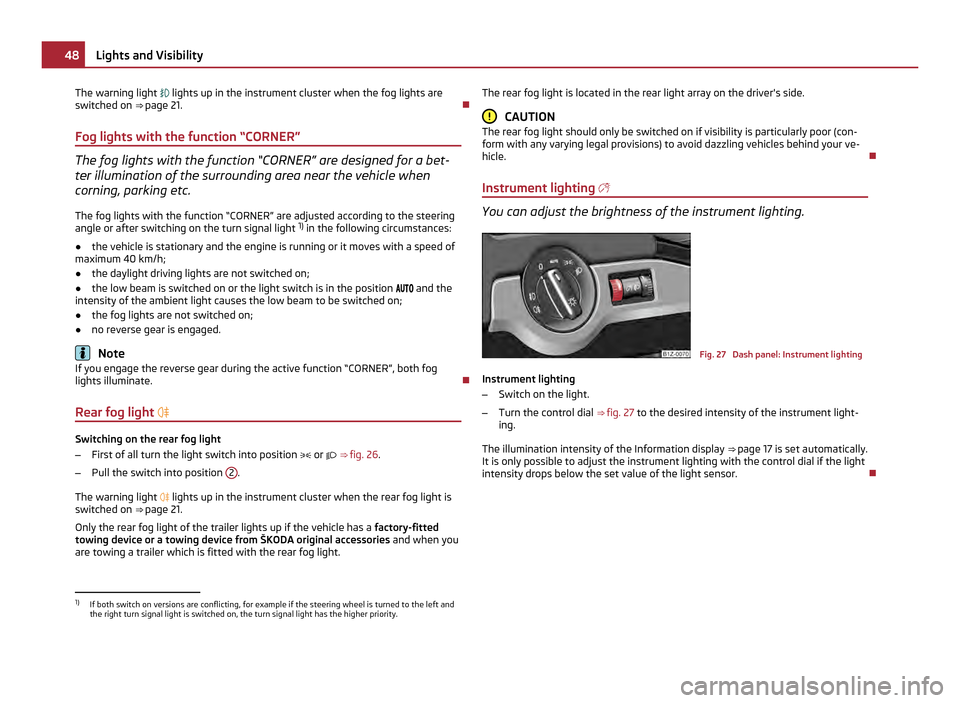
The warning light
lights up in the instrument cluster when the fog lights are
switched on ⇒
page 21.
Fog lights with the function “CORNER” The fog lights with the function “CORNER” are designed for a bet-
ter illumination of the surrounding area near the vehicle when
corning, parking etc.
The fog lights with the function
“CORNER” are adjusted according to the steering
angle or after switching on the turn signal light 1)
in the following circumstances:
● the vehicle is stationary and the engine is running or it moves with a speed of
maximum 40 km/h;
● the daylight driving lights are not switched on;
● the low beam is switched on or the light switch is in the position
and the
intensity of the ambient light causes the low beam to be switched on;
● the fog lights are not switched on;
● no reverse gear is engaged. Note
If you engage the reverse gear during the active function “CORNER”, both fog
lights illuminate.
Rear fog light Switching on the rear fog light
–
First of all turn the light switch into position or ⇒
fig. 26 .
– Pull the switch into position 2 .
The warning light
lights up in the instrument cluster when the rear fog light is
switched on ⇒ page 21.
Only the rear fog light of the trailer lights up if the vehicle has a factory-fitted
towing device or a towing device from ŠKODA original accessories and when you
are towing a trailer which is fitted with the rear fog light. The rear fog light is located in the rear light array on the driver's side. CAUTION
The rear fog light should only be switched on if visibility is particularly poor (con-
form with any varying legal provisions) to avoid dazzling vehicles behind your ve-
hicle.
Instrument lighting You can adjust the brightness of the instrument lighting.
Fig. 27 Dash panel: Instrument lighting
Instrument lighting
– Switch on the light.
– Turn the control dial ⇒
fig. 27 to the desired intensity of the instrument light-
ing.
The illumination intensity of the Information display ⇒ page 17 is set automatically.
It is only possible to adjust the instrument lighting with the control dial if the light
intensity drops below the set value of the light sensor. 1)
If both switch on versions are conflicting, for example if the steering wheel is turned to the left and
the right turn signal light is switched on, the turn signal light has the higher priority. 48
Lights and Visibility